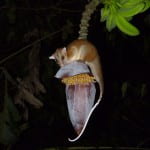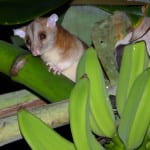This year we were not studying birds and did not have any ornithologists with us, but we still saw some interesting species. Some highlights include several pretty little hummingbirds including the Black-throated Mango, Long-tailed hermits, and white-necked Jacobans. We saw several hawks, but had a difficult time identifying them. One beautiful one we got a good look at was the Pearl Kite. I had never been to Fortuna and saw 12 new species just sitting on the front porch one morning. One of the cutest was the Rufous-collared sparrow. Feeding with the sparrows were a pair of Lesser Seed-finches and a male Yellow-faced Grassquit. I also saw several flycatchers, including a Yellow-bellied Elaenia. We caught a Yellow warbler and a Ringed Kingfisher in the bat nets at Bocas. We saw a pair of Linneated Woodpeckers and both Yellow and Red-rumped Caciques, and a Fasciated Antwren on Pipeline Road. At BCI we were able to see Crested Guans and a Red-capped Mannikan. We only saw 2 trogons: Slaty-tailed and Violaceous. Of course we saw lots of parrots and both Chestnut-mandibled and Keel-billed toucans, as well as Collared Aracaris. Two birds with great names, the Chacalacas and Bananaquits, were everywhere in Gamboa. In total we were able to identify about 65 species of birds without even looking for them. And I learned that I definiely need to study those large and mid-sized Tyrant Flycatchers.
Vicki





